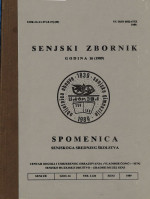Author(s): Lida Miraj / Language(s): Albanian
Issue: 1-2/2019
It has been possible to examine and copies of the correspondence between Albanian and Italian Governments in establishing the Italian Archaeological Mission, including some telegrams of Italian Legacies and, manuscripts by Ugolini himself, etc. These documents found in the Central Archives of the State in Tirana are found at the documentary funds of the Ministry of Education, the Council of Ministers, the Ministry of Interior and the Italian Legacy in Albania. Based on these documents, the official date or the first step towards the realization of Italian archaeological excavations in Albania was taken on April 12, 1924, when the Ministry of Education notified the Ministry of Interior that Dr. L. Ugolini a, “well-prepared Italian archaeologist in the prehistoric studies” and “a friend of Albania” would be visiting. The Albanian Embassy in Rome had informed the Ministry of Education of his visit. The letter of Roberto Paribeni on March 15, 1925 confirmed the beginning of archaeological excavations. On October 14, the head of the Italian Legation of Durrës wrote to his office in Saranda that the Albanian President had ordered local authorities to permit archaeological excavations in Feniki (Phoinike). The archaeological excavations began only in December 1926 and were very successful. But a year later, in December 1927, Ugolini informed the Albanian Minister of Education that the Italian Mission proposed to change the place of archaeological excavations from Phoinike to Butrinti (near Vivari lake in Santi Quaranta), and begin on the January 15, 1928. Only in spring 1928 Ugolini moved from Phoinike to Butrinti. Ugolini excavated at Butrint for eight years (1928-1936) despite many health problems. The voluminous correspondence, preserved in the Archives, shows his special personality and great passion for archaeology. On the evening of October 4, 1936 Ugolini died in Italy. On December 4, 1936 the Italian Ministry of Foreign Affairs announced that Roberto Paribeni, President of Reale Istituto Archeologico, had proposed Pirro Marconi, professor of Archaeology and Art History at the University of Naples and University of Palermo, as the successor to Ugolini and to be named as the Head of the Italian Archaeological Mission in Albania. Marconi’s activity in Butrint lasted just one year, because of his tragic death, flying to Rome, in late April 1938. After his death the excavations continued in June and July under Igino Epicoco and later that year, in accordance with a proposal by Roberto Paribeni, Domenico Mustilli, professor at the University of Naples, was named the director of Italian Archaeological Mission. The Italian surrender of September 1943 effectively ended all Italian concern with Butrint and with the archaeology of Albania. Italy had other more pressing problems closer to home. 29 November 1944, the Liberation day of Albania, opened a new chapter in its long history, the period of communism or the so called ‘proletarian dictatorship’ and, archaeology came to be organized in a very different way.
More...











